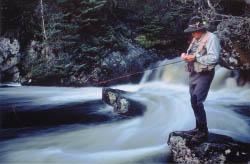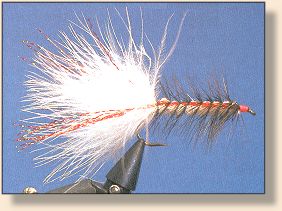The Absolute Beginner
The Ubiquitous Woolly Bugger

By Piscator
Many, if not most, fly fishers, if limited to only one fly, would most likely
choose the Woolly Bugger. It would certainly be my choice. First of all, unlike
imitative, specific patterns, the Woolly Bugger is an impressionistic pattern, which
suggest a wide variety of things most fish like to eat - leeches, crawfish, tadpoles,
and big nymphs such as Hexagenia. It works in both stillwater and fast water and
attracts just about every species of fish which can be taken on a fly rod.
 Of course, it's not the right fly to choose when fish are feeding selectively on
something which looks mothing like a Woolly Bugger - when trout are sipping
nothing but Hendrickson spinners, for instance. In such circumstances, the best fly
is one which most closely imitates the natural. But, in situations where fish are feeding
opportunistically rather than selectively - or not at all - the Woolly Bugger is the fly
to tie on.
Of course, it's not the right fly to choose when fish are feeding selectively on
something which looks mothing like a Woolly Bugger - when trout are sipping
nothing but Hendrickson spinners, for instance. In such circumstances, the best fly
is one which most closely imitates the natural. But, in situations where fish are feeding
opportunistically rather than selectively - or not at all - the Woolly Bugger is the fly
to tie on.
The Woolly Bugger is also a quick, easy tie. The basic pattern consists of only three
materisls: a marabou tail, a wrapped chenille body, and a palmered saddle hackle. I'm
far from an expert tyer, but I can crank out around a couple dozen in a hour. Nor does it
seem to matter much if they're not tied meticulously. In fact, the first efforts of a beginning
fly tyer, however messy, will usually take fish, particularly smallmouths in moving water.
This makes it the ideal first fly for the beginning fly fisher who is also just learning to
tie flies.
While the basic pattern is wonderfully versatile, it can be modified in a variety of ways
to make it even more versatile.
Tail Variations
The tail can be lengthened or shortened. A longer tail increases the undulating movement,
which more closely resembles creatures with long, undulating bodies, such as leeches.
A shorter tail if better for suggesting big nymphs or the claws of crayfish. The density
of the tail can also be varied to affect the sink rate: the sparser the tail, the faster the
fly will sink.
Hackle Varations
The longer and softer the hackle, the greater the built-in liveliness of the fly. A
long, soft hackle has a life of its own in still water, making it deadly on the sink or
the dead-slow, stop-and-start retrieve. A shorter, stiffer hackle is most effective
in fast water, as it is less prone to being flattened along the fly's body. A densely-palmered,
short, still hackle will give the fly buoyancy, so that it can be fished on or close to
the surface, especially if the tail is short.
Adding Things
A few strands of Krystal Flash or Flashabou added to the tail or run as a stripe
down each side of the body prior to palmering can give the Woolly Bugger that bit
of extra glitter, which sometimes is needed to turn the fish on. The popular Whitlock
Leech is basically an all-black Wooly Bugger with a purple Flashabout stripe down
each side and into the tail.
Adding a beadhead (metal or glass) is a more recent innovation. Besides changing the
silhouette of the fly, this also weights the fly, causing it to sink head-first, as if diving
for the bottom.
Colour Variations
The most popular colours for Woolly Buggers are black, purple, white, olives,
and browns - singly or in combinations. These colours approximate the colours
of most the living things the fly suggests. However, attractor colours are also
effective, especially in fluorescents. Chartreuse, hot orange, yellow, and
red - singly or in combination - are especially popular. The popular Egg-sucking
Leech is a combination of purple tail, body and hackle, with a fluorescent red
chenille head. Sometimes all that is needed ia a head of fluorescent red tying
thread. One of my personal favourites, inspired by those highly effective,
smoky-grey Powerbaits, incorporates this on a pattern with a white body
and tail and black hackle.
Size
 Woolly Buggers can be tied on hooks ranging from hooks as small as #10 2X long,
to huge 8/0 saltwater models. The smaller sizes in natural colours are great for suggesting
nymphs. The big versions are usually used for attractor patterns. The 8/0 Megabuggers
are great for pike. I remember one August in Labrador when one of these in red and
white as the hot ticket for big brookies. When tying the Megabugger, it's necessary
to use more than one hackle feather, as the hook shank is so long. This is an excellent
opportunity for creating a two or even three-tone hackle.
Woolly Buggers can be tied on hooks ranging from hooks as small as #10 2X long,
to huge 8/0 saltwater models. The smaller sizes in natural colours are great for suggesting
nymphs. The big versions are usually used for attractor patterns. The 8/0 Megabuggers
are great for pike. I remember one August in Labrador when one of these in red and
white as the hot ticket for big brookies. When tying the Megabugger, it's necessary
to use more than one hackle feather, as the hook shank is so long. This is an excellent
opportunity for creating a two or even three-tone hackle.
Fishing Techniques
Nymph and grub-like Woolly Buggers can be fished dead drift, sink-and-draw, or
crawled along the bottom. Attractor variants are usually best fished on the swing
or on a stripped or twitched retrieve. However, this pattern is so versatile that these
guidelines should not be regarded as written in stone. It pay to creative, not only
in tying variants, but also in presentation.
~ Piscator
|

